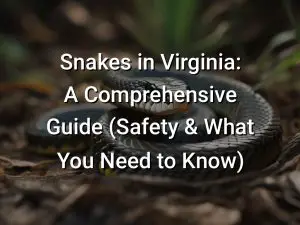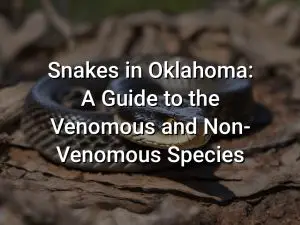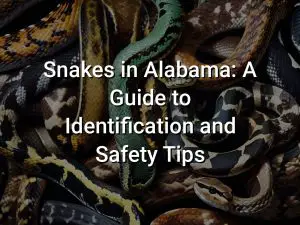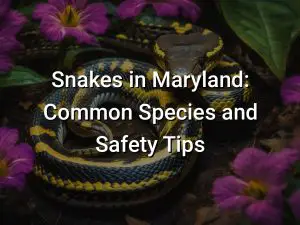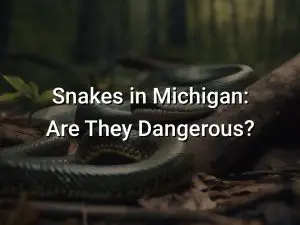Snakes in Wyoming: A Complete Guide (Facts & Safety Tips)
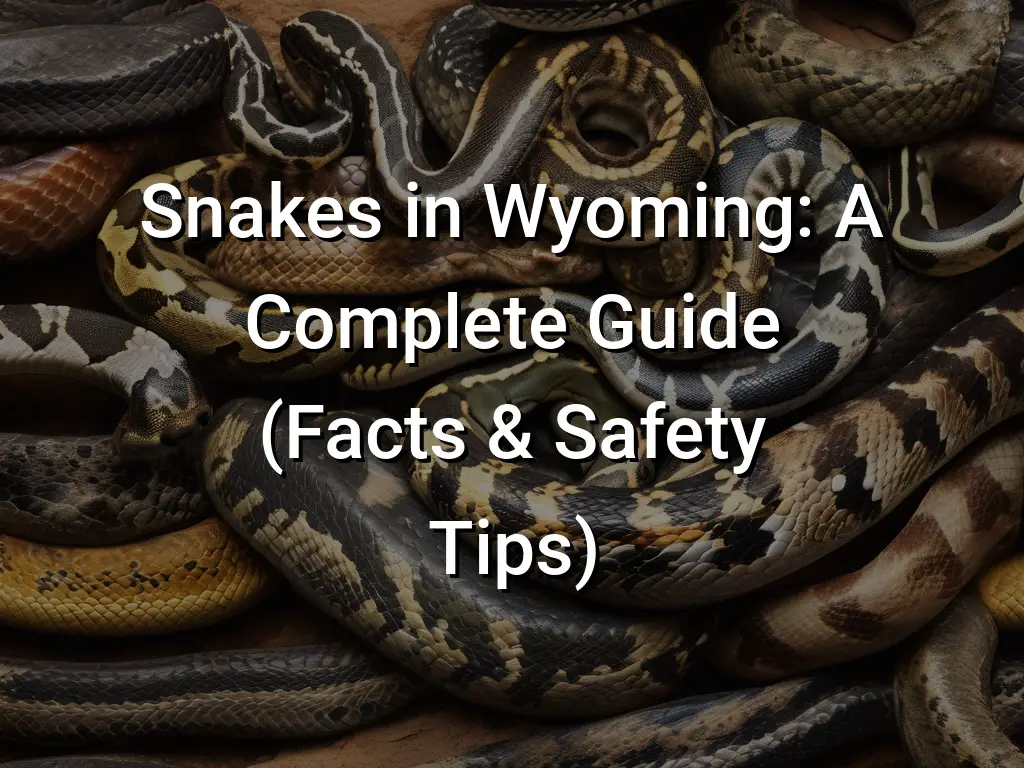
Whether you’re a nature enthusiast, a wildlife admirer, or simply curious about the reptiles that inhabit the great state of Wyoming, this complete guide to snakes in Wyoming is here to offer you valuable insights and safety tips. From venomous to non-venomous, we’ll cover everything you need to know about snakes in Wyoming.
With a diverse range of snake species, Wyoming is home to some fascinating reptiles. In this guide, we’ll delve into the behavior and habits of snakes, identify the most common species found in Wyoming, and provide essential safety tips to ensure you can confidently explore the wilderness. So, let’s slither into the world of Wyoming’s snakes!
Quick Links
Common Snake Species in Wyoming
Wyoming is home to a diverse range of snake species, each adapted to the unique habitats found throughout the state. While some snakes are commonly encountered, others are more elusive and harder to spot. Here are some of the common snake species you may come across in Wyoming:
- Garter Snake: Garter snakes are one of the most common snake species in Wyoming. They are non-venomous and have distinctive stripes running along their bodies.
- Bullsnake: Bullsnakes are large and robust snakes known for their resemblance to rattlesnakes. However, they are non-venomous and play an important role in rodent control.
- Rattlesnake: Wyoming is home to several species of venomous rattlesnakes, including the Western Rattlesnake and the Prairie Rattlesnake. These snakes have distinctive rattles on their tails and should be treated with caution.
- Gopher Snake: Gopher snakes are non-venomous and often mistaken for rattlesnakes due to their similar appearance and defensive behaviors.
- Milk Snake: Milk snakes are small and typically have colorful patterns on their bodies. They are non-venomous and feed on small rodents.
These are just a few examples of the snake species you may encounter in Wyoming. Remember to always give snakes their space and avoid handling or disturbing them to prevent any potential harm.
Snake Behavior and Habits
Snakes are fascinating creatures with unique behavior and habits. Understanding their behavior can help you stay safe and appreciate these incredible reptiles. Here are some key points about snake behavior and habits:
- Nocturnal and Diurnal: Snakes can be nocturnal (active at night) or diurnal (active during the day), depending on the species. Some snakes, like the Western rattlesnake, are more active during the early morning or evening.
- Basking: Snakes are ectothermic, meaning they rely on external sources of heat to regulate their body temperature. They often bask in the sun to warm themselves up, especially in the cooler morning hours.
- Hunting and Feeding: Snakes are carnivorous and feed on a variety of prey, including rodents, birds, and amphibians. They use their venom or constriction to subdue and kill their prey before swallowing it whole.
- Slithering and Locomotion: Snakes move by slithering, which is a form of lateral undulation. They use the scales on their bellies to push against the ground, propelling themselves forward.
- Habitats: Snakes can be found in a variety of habitats, including forests, grasslands, deserts, and wetlands. They have adapted to different environments and can be expert camouflagers.
- Hibernation and Brumation: In colder regions, snakes hibernate or brumate during the winter months. They find shelter in burrows or crevices to protect themselves from freezing temperatures.
- Mating and Reproduction: Snakes reproduce sexually, with males often engaging in courtship rituals to attract females. After mating, female snakes can lay eggs (oviparous) or give birth to live young (viviparous), depending on the species.
- Shedding: Snakes shed their skin periodically as they grow. During this process, known as ecdysis, snakes loosen their old skin and slither out of it, revealing a fresh, vibrant new layer underneath.
Remember, snakes are generally not aggressive and prefer to avoid confrontation. If you encounter a snake, it’s best to keep your distance and observe it from a safe distance. Appreciate their natural beauty and importance in maintaining a balanced ecosystem.
Venomous Snakes in Wyoming
Wyoming is home to several species of venomous snakes, although encounters with them are relatively rare. It’s important to be aware of these venomous snakes and understand how to stay safe if you come across one. Here are some of the venomous snakes found in Wyoming:
- Prairie Rattlesnake: The prairie rattlesnake is the most common venomous snake in Wyoming. It has a distinctive rattle on its tail and can be found in a variety of habitats, including prairies, grasslands, and rocky areas. If you encounter a prairie rattlesnake, keep a safe distance and do not provoke it.
- Midget Faded Rattlesnake: The midget faded rattlesnake is a small, venomous snake that is primarily found in the western part of Wyoming. It is usually found in rocky areas and has a gray or pale coloration. Be cautious if you come across a midget faded rattlesnake, as its venom can be dangerous.
- Massasauga: The Massasauga is a small, venomous rattlesnake found in the eastern part of Wyoming. It prefers wetland habitats, such as swamps and marshes. The massasauga has a venomous bite, so it’s important to give it space and avoid handling it.
If you encounter a venomous snake in Wyoming, it’s important to remember the following safety tips:
- Stay calm and slowly back away from the snake.
- Do not try to handle or capture the snake.
- Do not provoke or antagonize the snake in any way.
- Keep a safe distance and give the snake space to retreat.
- If you are bitten by a venomous snake, seek medical attention immediately.
Remember, snakes play an important role in the ecosystem and should be respected and admired from a safe distance.
Non-venomous snakes in Wyoming
Wyoming is home to several non-venomous snake species that play an important role in the ecosystem. While these snakes may not pose a threat to humans, it’s important to still exercise caution and respect their space when encountering them in the wild.
One common non-venomous snake found in Wyoming is the Bullsnake. Bullsnakes are known for their impressive size, reaching up to 6 feet in length. They have a distinctive pattern of blotches or bands that help camouflage them in their natural habitats. Bullsnakes are constrictors and primarily feed on small mammals and birds.
Another non-venomous snake species found in Wyoming is the Gopher Snake. Gopher snakes are similar in appearance to Bullsnakes and share their habitat preferences. These snakes are also constrictors and feed on rodents, making them beneficial for controlling rodent populations in agricultural areas.
The Plains Gartersnake is another non-venomous species commonly found in Wyoming. These snakes are smaller in size, usually growing up to 2 feet long. Plains Gartersnakes are harmless and primarily feed on amphibians, fish, and small mammals.
The Western Terrestrial Gartersnake is another non-venomous snake species you may encounter in Wyoming. These snakes are typically found near wetland areas and have a varied diet consisting of small mammals, fish, and amphibians.
It’s important to remember that even non-venomous snakes can bite if they feel threatened or cornered. If you come across a non-venomous snake in Wyoming, it’s best to maintain a safe distance and observe it from afar. Avoid trying to handle or provoke the snake, as this can lead to defensive behavior.
Non-venomous snakes play an essential role in maintaining the balance of ecosystems in Wyoming. They help control rodent populations and serve as a food source for other wildlife. By respecting and appreciating these creatures, we can coexist peacefully with them in their natural habitats.
Snake Safety Tips
Snakes are a common sight in the wilderness of Wyoming, and while most snakes are not venomous, it’s important to take precautions to stay safe. Here are some snake safety tips to keep in mind:
- Be aware of your surroundings: When hiking or exploring areas known for snakes, be aware of your surroundings and watch where you step or place your hands.
- Stick to well-traveled paths: Snakes are more likely to be found in tall grass or rocky areas, so stick to well-traveled paths to minimize the risk of encounters.
- Wear appropriate footwear: When in snake-prone areas, wear closed-toe shoes or boots to protect your feet from potential snake bites.
- Avoid reaching into dark or concealed areas: Snakes may seek shelter in dark and concealed areas, such as rock crevices or fallen logs. Avoid reaching into these areas without first checking for snakes.
- Do not disturb snakes: If you encounter a snake, do not try to handle or disturb it. Keep a safe distance and allow the snake to move away on its own.
- Do not provoke or antagonize snakes: Snakes may become defensive if they feel threatened. Avoid provoking or antagonizing snakes, as this increases the risk of a snake bite.
- Learn to identify venomous snakes: Familiarize yourself with the venomous snake species in Wyoming, such as the rattlesnake, and learn to identify their distinguishing features.
- Carry a snakebite kit: When venturing into snake-prone areas, it’s a good idea to carry a snakebite kit with you. The kit should include items such as bandages, antiseptic, and a suction device for removing venom.
- Know snakebite first aid: Familiarize yourself with snakebite first aid techniques, such as keeping the affected limb immobilized and seeking medical help immediately.
- Stay calm: In the event of a snake encounter or snakebite, it’s important to stay calm. Panicking can increase your heart rate and spread venom more quickly through your system.
By following these snake safety tips, you can enjoy Wyoming’s natural beauty while minimizing the risk of snake encounters and snake bites.
Snakebite First Aid
If you or someone you know is bitten by a snake in Wyoming, it’s important to take immediate action. Here are some essential first aid steps to follow:
- Stay calm: Try to remain calm and keep the affected person calm as well. Panic can increase the heart rate and spread venom more quickly through the body.
- Call for help: Dial emergency services or seek medical attention as soon as possible. It’s essential to get professional medical help in case of a snakebite.
- Position the affected area: If possible, immobilize the bitten limb and keep it at or below the level of the heart. This can help slow the spread of venom.
- Remove constrictive items: Take off any tight clothing, jewelry, or accessories near the bite site. Swelling can occur, and these items may restrict blood flow if left in place.
- Do not: Do not try to capture or kill the snake for identification purposes. This can put you at unnecessary risk of another bite.
- Do not: Do not attempt to suck out venom or make any incisions near the bite. These practices are no longer recommended and can sometimes do more harm than good.
- Do not: Do not apply a tourniquet or constricting bandage above the bite site. This can cut off blood flow and result in further complications.
- Keep the person still: Encourage the person to stay as still as possible to slow the spread of venom through the body. Immobilize the limb if necessary.
- Monitor vital signs: Keep an eye on the person’s breathing, heart rate, and level of consciousness. If any signs of severe allergic reactions or shock develop, be prepared to perform CPR or administer emergency care.
Remember, snakebite first aid should never replace professional medical treatment. Always seek immediate medical attention following a snakebite, even if you believe it was from a non-venomous snake.
Snakebite Prevention
While encountering snakes in Wyoming is relatively rare, it’s important to take precautions to prevent snakebites when exploring nature. Here are some snakebite prevention tips:
- Stay on designated trails and avoid tall grass or dense vegetation where snakes may be hiding.
- Wear sturdy boots and long pants to protect your legs from potential snake encounters.
- Be cautious when lifting rocks, logs, or other items as snakes may be sheltering underneath.
- Avoid reaching into dark or hidden spaces without first checking for snakes.
- Be aware of your surroundings and watch where you step to avoid accidentally stepping on a snake.
- Do not provoke or handle snakes, even if they appear non-venomous.
- Keep your distance if you encounter a snake and allow it to move away on its own.
- Be mindful when camping or picnicking to keep food and garbage sealed and stored properly, as snakes may be attracted to these food sources.
- If you have a backyard or garden, make it less appealing to snakes by keeping the area tidy, removing potential shelters like brush piles, and keeping grass short.
- Consider installing snake barriers (e.g., wire mesh fences) around your property to minimize the chances of snakes entering.
- Teach children about snake safety and the importance of not approaching or touching snakes.
By following these snakebite prevention tips, you can minimize the risk of encountering snakes and reduce the likelihood of snakebite incidents. Remember, prevention is key when it comes to snake safety.
Snake Conservation in Wyoming
Snake conservation is an important aspect of wildlife management in Wyoming. The state is home to a diverse range of snake species, including both venomous and non-venomous snakes, each playing a vital role in the local ecosystem.
Conservation efforts in Wyoming focus on protecting snake habitats and promoting public awareness and education about these fascinating reptiles. The state’s conservation agencies work to monitor snake populations, study their behavior and habits, and implement measures to ensure their survival.
One key aspect of snake conservation in Wyoming is preserving and restoring their natural habitats. Snakes rely on specific habitats for foraging, breeding, and shelter. By protecting and restoring these habitats, conservationists can provide snakes with the resources they need to thrive.
Education and public outreach programs also play a crucial role in snake conservation. These initiatives aim to dispel misconceptions and fears about snakes, ultimately promoting their protection and coexistence with humans. Public awareness campaigns emphasize the importance of snakes to the ecosystem and highlight ways in which individuals can contribute to their conservation.
Additionally, snake conservation efforts in Wyoming involve collaboration with landowners, researchers, and wildlife enthusiasts. By fostering partnerships and gathering scientific data, conservationists can make informed decisions to promote the long-term survival of snake populations.
Overall, snake conservation in Wyoming is a multifaceted endeavor that strives to protect these remarkable creatures and their habitats. Through habitat preservation, public education, and collaborative efforts, Wyoming aims to ensure the continued existence of its snake species for future generations.
Conclusion
Snakes play an important role in Wyoming’s ecosystem, but it’s important to understand and respect them to ensure your safety and the conservation of these creatures. By familiarizing yourself with the common snake species in Wyoming and learning about their behavior and habits, you can better understand how to avoid potential interactions with these reptiles.
Remember to always practice snake safety by keeping a safe distance, wearing appropriate footwear and clothing when hiking, and being cautious when reaching into rocky or wooded areas. In the event of a snakebite, it’s important to seek immediate medical attention and apply first aid techniques while waiting for help to arrive.
With a combination of knowledge, awareness, and respect, you can coexist with snakes in Wyoming and appreciate the unique role they play in the natural world.

